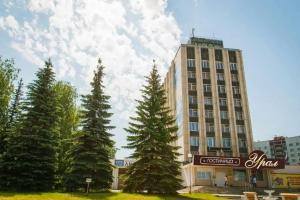Ozyorsk
Description
Ozyorsk or Ozersk (Russian: Озёрск) is a closed city in Chelyabinsk Oblast, Russia. The population was: 82,164 (2010).
History
The town was founded on the shores of Lake Irtyash in 1947. Until 1994, it was known as Chelyabinsk-65, and even earlier, as Chelyabinsk-40 (the digits are the last digits of the postal code, and the name is that of the nearest big city; which was a common practice of giving names to closed towns).
Codenamed City 40, Ozersk was the birthplace of the Soviet nuclear weapons program after the Second World War. In 1994, it was granted town status and renamed Ozyorsk.
Radioactive contamination and the 1957 disaster
Ozyorsk along with Richland, Washington, were the first two cities in the world to produce plutonium for use in cold war atomic bombs.
The Chelyabinsk region has been reported as being one of the most polluted places on Earth, having previously been a center of production of weapons-grade plutonium.
Kyshtym disaster
Ozyorsk and the surrounding countryside have been heavily contaminated by industrial pollution from the Mayak plutonium plant since the late 1940s. The Mayak plant was one of the largest producers of weapons-grade plutonium for the Soviet Union during much of the Cold War, particularly during the Soviet atomic bomb program. Built and operated with great haste and disregard for safety, largely out of gaps in information, between 1945 and 1957 the plant dumped and released large amounts of solid, liquid and gaseous radioactive material into the area immediately around the plant. Over time, the sum of radionuclide contamination is estimated to be 2-3 times the release from the explosions from the Chernobyl accident.
In 1957, the Mayak plant was the site of a major disaster, one of many other such accidents, releasing more radioactive contamination than Chernobyl. An improperly stored underground tank of high-level liquid nuclear waste exploded, contaminating thousands of square kilometres of territory, now known as the Eastern Ural Radioactive Trace (EURT). The matter was quietly and secretly covered up, and few either inside or outside Russia were aware of the full scope of the disaster until 1980.
Before the 1957 accident, much of the waste was dumped into the Techa River, which it severely contaminated as well as residents of dozens of riverside villages such as Muslyumovo, who relied on the river as their sole source of drinking, washing and bathing water. After the 1957 accident, dumping in the Techa River officially ceased, but the waste material was dumped in convenient shallow lakes near the plant instead, of which 7 have been officially identified. Of particular concern is Lake Karachay, the closest lake to the plant (now notorious as the most contaminated place on Earth) where roughly 4.4 exabecquerels of high-level liquid waste (75-90% of the total radioactivity released by Chernobyl) was dumped and concentrated in the shallow 45-hectare (110-acre) lake over several decades.
In addition to the radioactive risks, the airborne lead and particulate soot levels in Ozyorsk (along with much of the Ural industrial region) are also very high—roughly equal to the levels encountered along busy roadsides in the era predating unleaded gasoline and catalytic converters—due to the presence of numerous lead smelters.
Radioactive contamination of the local population
While the environmental impact of the disaster was immense, the contamination of the local populace was equally devastating. The average person living in Ozyorsk, 8 km from the Mayak Nuclear Facility, had a long term radioactive burden on their body at 17 Bq. Because of the large amounts of radioactive materials that were discharged into the atmosphere, over 22 small towns throughout the region were evacuated. Some cities took two years for a full evacuation to take place.
Reports indicated that humans living in the affected area during the time that the disaster took place and their offspring have developed problems with reproductive functions, mortality, age structure, and gender deformities. These populations were recorded at experiencing a radioactive exposure of 40-500 mSv.
Education and culture
There are seventeen different cultural and public-service institutions.
There are sixteen secondary schools, two schools specializing in the English language, one gymnasium, physics-mathematics lyceum, three professional colleges, Southern-Ural Polytechnical College, Music College, Ozyorsk Engineering Institute (an affiliate of National Research Nuclear University MEPhI), and affiliates of Yekaterinburg's and Chelyabinsk's universities.
In popular culture
City 40 is a documentary film about the town, by Samira Goetschel, released in July 2016.




